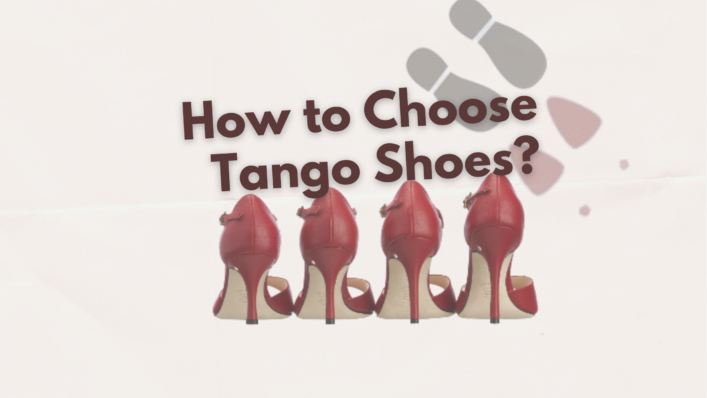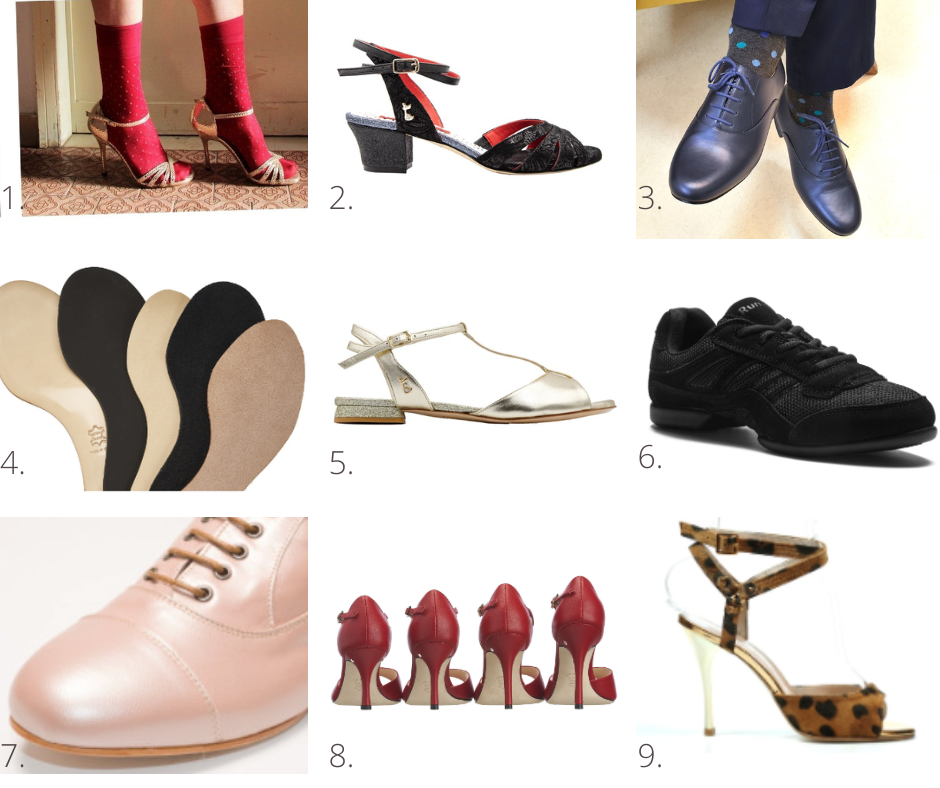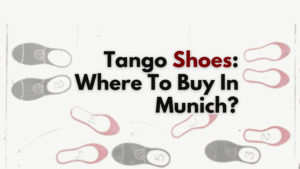
How to Choose Tango Shoes?
We get this question from our students a lot, and it always makes us very happy as it shows interest and engagement. In this post, we share a few tips to consider before purchasing. Once you know how to choose tango shoes, we’ll show you where you can try on shoes in Munich before buying them (which we highly recommend). Check the next post.
Sole
It’s very important to wear shoes that allow pivoting. The best shoes have leather or suede soles. What also matters is that the sole is flexible and allows your foot to roll on the floor. Leaders as well as followers should pay attention to this. If you want to dance in your sneakers at the beginning of your tango journey, you can use sole stickers to make them more slippery for better pivoting. These stickers, made of durable cloth tape, allow you to glide and spin across the floor with ease. Simply apply the sticker to the sole of your clean and dry sneakers in the spin spot area to prevent traction and sticking to the floor, transforming any type of footwear into dance shoes and any floor into a dance floor.
Size
Once these criteria have been met, the shoe must fit your foot. Since tango shoes are usually made of leather, they might become slightly looser after some time with regular wear. Consider this when buying; they shouldn’t be loose already at the moment when you buy them. Choose a snug fit initially to accommodate the natural stretching of the leather, ensuring a comfortable and secure fit as they break in.
Unconventional Size
If your feet are wider or slimmer than ‘usual’, opt for brands offering different shapes like Madame Pivot, Regina, and Odile, which provide various widths. Consider custom-made shoes for specific requirements. When trying on shoes, ensure comfort across the width of your foot. Finding the right fit enhances your dancing experience and prevents discomfort or injury.

High Heels
Followers, I would like to remind you that wearing high heels is not obligatory when dancing tango. However, wearing high heels can be beneficial as it shortens the calf muscle, making it contract faster, which is essential for executing the numerous pivots in tango. There are many heel types available to suit different preferences and experience levels. Starting from very flat options, like the great new models from Tangolera and Regina with only a 1 cm heel (pic. 5), to a 4 cm block heel (Tangolera, pic. 2), to a 7 cm thicker and more stable heel (Rallies model from Madame Pivot), and various popular stiletto heels ranging from 7 to even 11 cm high. If you are just starting out and are not comfortable with a 9 cm stiletto, choose a lower heel and work your way up (pic. 8). Remember to listen to your body and ensure proper technique to prevent injury as you transition to higher heels.
Closed vs. Open Heel
There are two types of heel cages commonly found in tango shoes: open and enclosed. The choice between them often comes down to personal preference and style, but there are some practical considerations as well.
- Enclosed Heel Cage: Tango shoes with an enclosed heel cage feature a solid piece of material that wraps around the back of the heel, providing maximum stability and support. This design ensures that heels stay firmly in place during complex movements and spins, offering added protection for the heel and preventing accidental slipping.
- Open Heel Cage: Shoes with an open heel cage have a more minimalist design where the back of the heel is left partially exposed. This style tends to be lighter and more flexible, allowing for greater freedom of movement and articulation in the ankle. However, while open heel cages offer more freedom, they may provide slightly less support and stability compared to enclosed designs.
Ultimately, the choice between an open and enclosed heel cage depends on the specific demands of your dance style and your comfort preferences. It’s essential to try on both types and see which feels best for you, ensuring that the rest of the shoe fits properly and securely regardless of the heel cage style you choose.
Practice Shoes
Apart from a pair of high heels, you might want to have also a pair of practice shoes for practicas, or classes. You will find them in the offer of many tango shoe brands in the derby shape (pic. 7, from Regina) or dance sneakers (some of the latter come also with leather or suede soles! e.g. Rumpf, pic. 6).
Tango Brands
Here are a few brands with beautiful designs and great quality hand-made tango shoes for both roles:
Italy: Madame Pivot, Tangolera, Regina, SUR, Alagalomi, Pluma, Entonces
Romania: Mono (customizable!)
Greece: Cardou, Christina Rojer
Turkey: Turquoise, Concordance (for men especially), Sibel Saraç, Tanguera
Argentina: Mosh Mosh, Neo Tango, Comme il Faut, DNI
Korea: Odile
The images in the graphic are from the following websites: madamepivot.com, rumpf.net, tangoshoesodile.com, reginatangoshoes.com, tangolerashoes.com

